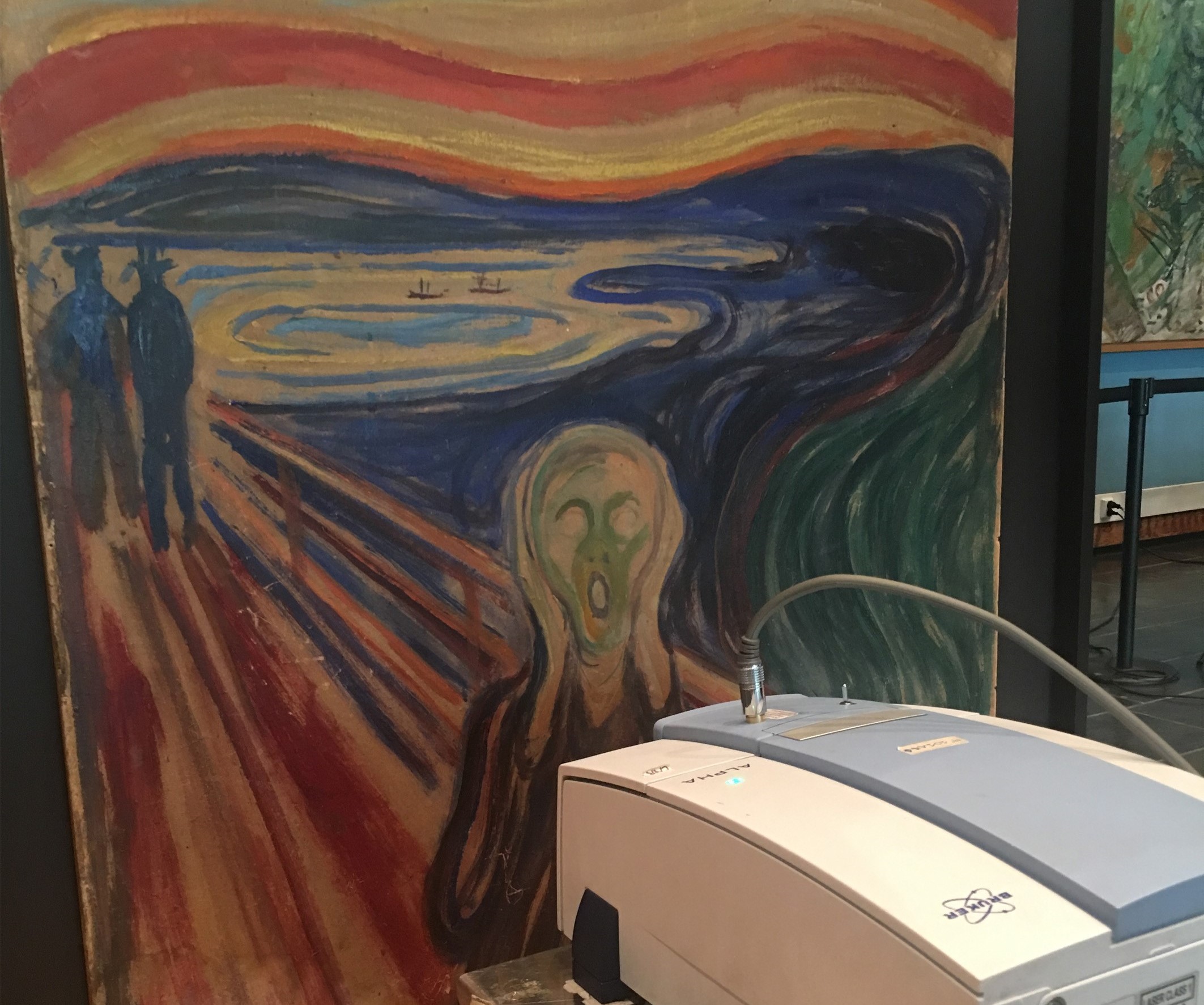 Maths, Physics & Chemistry
Maths, Physics & Chemistry
Saving the cadmium yellow pigments in The Scream
In situ non-invasive spectroscopic methods combined with synchrotron radiation X-ray techniques allowed us to unveil that moisture, but not light, is the main factor triggering the degradation of cadmium yellow paints in The Scream (ca. 1910) by Edvard Munch (Munch Museum, Oslo). The findings will contribute to preserve the masterpiece, which is rarely exhibited due to its tendency to degrade.

The Scream, realized by Edvard Munch between 1893 and 1916, is one of the most famous series of artworks of the modern era, symbolizing anxiety and anguish. There are a number of versions of The Scream: two paintings, two pastels, several lithographic prints and a few drawings and sketches. The most well-known versions are the two paintings made in 1893 and ca. 1910, which now belong to the National Gallery and the Munch Museum in Oslo (Norway), respectively. Munch experimented with the use of a wide range of materials, by mixing different binding media (tempera, oil and pastel) with brilliant and bold synthetic pigments to make "screaming colors". Unfortunately, the extensive use of such new colors poses a challenge for the long-term conservation of Munch's artworks.
The ca. 1910 version of the Scream exhibits clear signs of degradation, most obviously where cadmium sulphide-based pigments (known as cadmium yellows) have been employed: some yellow brushstrokes have turned to an off-white color in the cloudy sky and in the neck area of the central figure. In the lake region, a thickly applied opaque yellow paint is flaking. A number of factors have played a key-role in the degradation of the painting: the type of yellow pigments used, the storage environment and the theft of 2004, when the masterpiece disappeared for about two years. Since the recovery of the painting after the theft, the Scream (ca. 1910) is kept in a storage room at the Munch Museum, under controlled conditions of lighting, temperature and humidity, and is only occasionally exhibited to the public.
Previous studies of microsamples of The Scream revealed that cadmium carbonate - rather than the expected cadmium sulphide - is the main component of the paler yellow tones of the sky and the central figure's neck. In the lake region, the cadmium carbonate had been found in mixture with varying amounts of sulphur, chlorine and sodium compounds. These results left a series of questions unanswered: Is the extent of degradation in the cadmium yellow paint linked to its chemical composition? Into which compounds had the cadmium yellows degraded? And lastly, what are the causes of degradation of such yellow paints?
To answers these questions, we studied selected cadmium sulphide-based regions of The Scream (ca. 1910) by a set of spectroscopic methods via the European MOLAB platform, a network of facilities that supplies portable equipment for non-invasive measurements on artworks. Moreover, we investigated a minute sample, obtained by scraping-off a spot of the flaking yellow surface of the lake area, using a wide range of synchrotron radiation-based X-ray methods at the European Synchrotron Radiation Facility (ESRF) in Grenoble, France and the German Electron Synchrotron (DESY) in Hamburg, Germany.
In parallel to studying the painting directly, we investigated artificially aged oil paint mock-ups that had a similar composition to the lake yellow area. We prepared the mock-ups using an early 20th century cadmium yellow pigment powder and a cadmium yellow oil paint that once belonged to Munch himself. We also obtained another set of mock-ups by mixing powders of cadmium sulphide with equal amounts of sodium sulphate and cadmium chloride.
The experiments using paint mock-ups prove that, in high-moisture conditions, the original yellow cadmium sulphide converts into white cadmium sulphate in the presence of chloride-containing compounds. This takes place even in the absence of light and does not occur on chlorine-free oil paint mock-ups aged under similar conditions.
Our findings provide relevant hints about the deterioration mechanism of cadmium sulphide-based paints, with significant implication for the preventive conservation of the ca. 1910 version of The Scream. To mitigate further degradation of the cadmium yellow paints, the painting should be kept at low humidity conditions, while lighting conditions should follow the recommendations of the International Commission on Illumination.
Munch's contemporaries, such as Henri Matisse, Vincent van Gogh and James Ensor, also used cadmium yellows. Thus, the outcomes of our study may contribute to the development of conservation strategies for artworks by these artists too.
Original Article:
Monico, L. et al. Probing the chemistry of CdS paints in the Scream by in situ noninvasive spectroscopies and synchrotron radiation x-ray techniques. Sci. Adv. 6, 1-12 (2020).
Edited by:
Dr. Ayala Sela , Associate Editor
We thought you might like
Man-made check dams alter tadpole growth and activity
Jun 7, 2023 in Evolution & Behaviour | 3 min read by Jithin V.Viruses are spilling over from managed honey bees to wild bumble bees
Mar 13, 2020 in Evolution & Behaviour | 4 min read by Samantha A. AlgerNature favors simplicity and symmetry in biological forms
May 26, 2023 in Evolution & Behaviour | 4 min read by Kamaludin DingleKilling C. difficile with targeted strikes
Jul 24, 2018 in Microbiology | 3.5 min read by Joseph KirkMore from Maths, Physics & Chemistry
Testing gravity through the distortion of time
Sep 20, 2024 in Maths, Physics & Chemistry | 3 min read by Sveva CastelloStacking molecular chips in multiple dimensions
Aug 30, 2024 in Maths, Physics & Chemistry | 3 min read by Lucía Gallego , Romain Jamagne , Michel RickhausReversible Anticoagulants: Inspired by Nature, Designed for Safety
Jun 12, 2024 in Maths, Physics & Chemistry | 4 min read by Millicent Dockerill , Nicolas WinssingerDistance-preserving moves always keep a point fixed
May 18, 2024 in Maths, Physics & Chemistry | 4 min read by Shaula FiorelliA resonance triggers chemical reactions between the coldest molecules
Apr 5, 2024 in Maths, Physics & Chemistry | 3 min read by Juliana Park , Wonyl ChoiEditor's picks
Trending now
Popular topics


